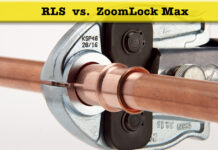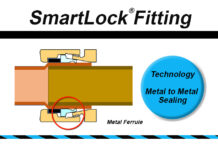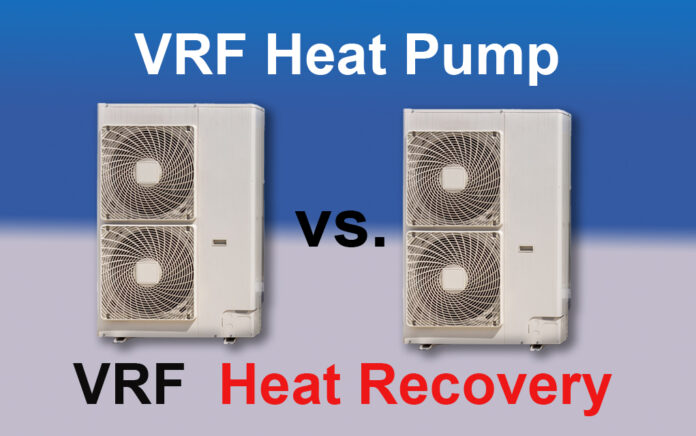VRF Heat Pump or Heat Recovery (How to choose between a VRF Heat Pump or Heat Recovery System) or Packaged DX
Scroll to the bottom if you prefer to watch the video.
VRF systems are responsive to variations in cooling and heating demand as compared to the traditional AC unit that has a fixed speed compressor and fan. VRF system provide for varying the energy consumption by varying the speed of the compressor or outdoor unit fans based on the demand. If the traditional packaged or split system DX units are oversized, they’ll short circuit on and off.
How do you determine which system to use for a particular building or space type? Is a VRF Heat Pump or a Heat Recovery System better than a conventional Packaged DX unit?
Of course, VRF Heat Recovery Systems are a little more complex and cost more than a heat pump or traditional DX unit. But when do you choose one system over the other? So, how do you decide if a VRF system is feasible for your project?
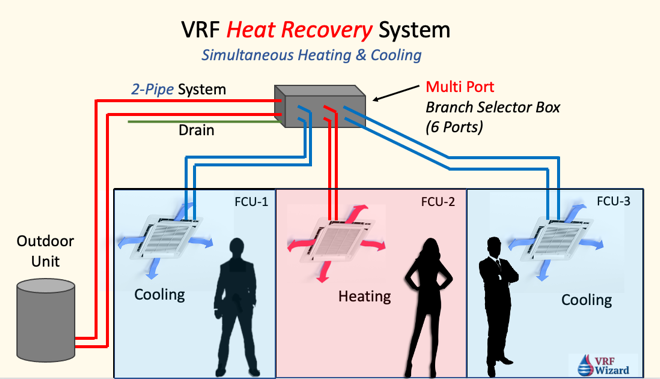
Some of the key items to look for when deciding are the owner’s requirements, zoning layout, building orientation, the need for simultaneous heating and cooling, the space available for running piping or ductwork, ventilation requirements as mandated by code and building profile.
Energy Efficiency
One of the benefits of a VRF system over the traditional DX packaged or split system is that it runs on less energy. Because the variable speed compressor can ramp up or down with demand, which makes it more efficient that the on/off style of the standard compressor in a DX system. This allows the compressor to run at part load where it is more efficient. Also, the outdoor fan may have the option of also ramping up and down with demand.
Ventilation Requirements
ASHRAE Standard 62.1, Ventilation for Acceptable Indoor Air Quality, and any local building codes will define the fresh air requirements for the occupancy type. There are many approaches to this depending on the quantity of ventilation air required to each space and the design outdoor conditions.
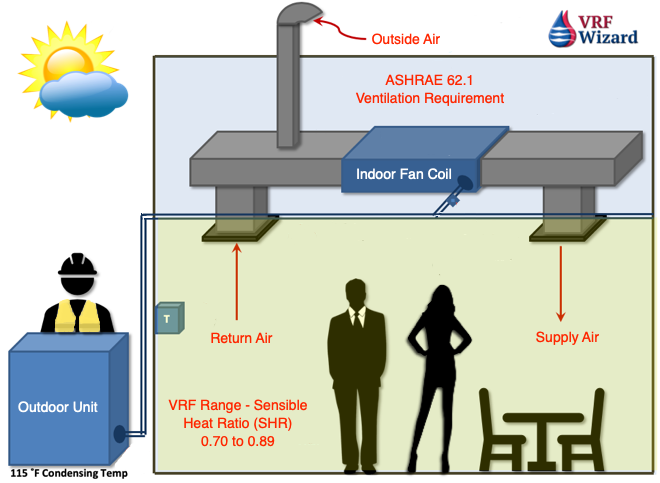

In high humidity locations the need to precondition the air to remove moisture will need to be considered as the VRF fan coils can handle only a small amount of latent. See the sensible heat ratio for the VRF manufacture that you’re considering. See our article on DOAS units that serve the function of providing code required ventilation air and the various methods to do so.
With Packaged DX units outside there is no need to worry about ducting ventilation air. This requirement arises anytime you use a split system of any kind.
Heating and Cooling Simultaneously
This is the defining question when it comes to the type of VRF system to use. A VRF Heat Pump system doesn’t provide simultaneous heating and cooling. With a VRF Heat Pump you must have all the connected zones (Indoor Fan Coils) in either heating or cooling mode. Using a VRF Heat Recovery system allows you to have simultaneous Heating and Cooling to the various zones being fed from the same outdoor unit(s).
If the layout allows and the orientation and zone configurations are similar, you may be able to combine zones and use a VRF Heat Pump system. If you can provide a Heat Pump instead of a Heat Recovery system, then you can reduce complexity and cost. You will need to consider how the spaces are configured and if they share the same orientation to the sun and will experience similar thermal loading. If the zones don’t have similar orientation, then that’s when you’ll need to either make smaller VRF Heat Pump zones that are similar in load profile or use a VRF Heat Recovery System. You can see in the image below that with a heat pump system you’ll have all zones in Heating or Cooling, there is no simultaneous heating and cooling.
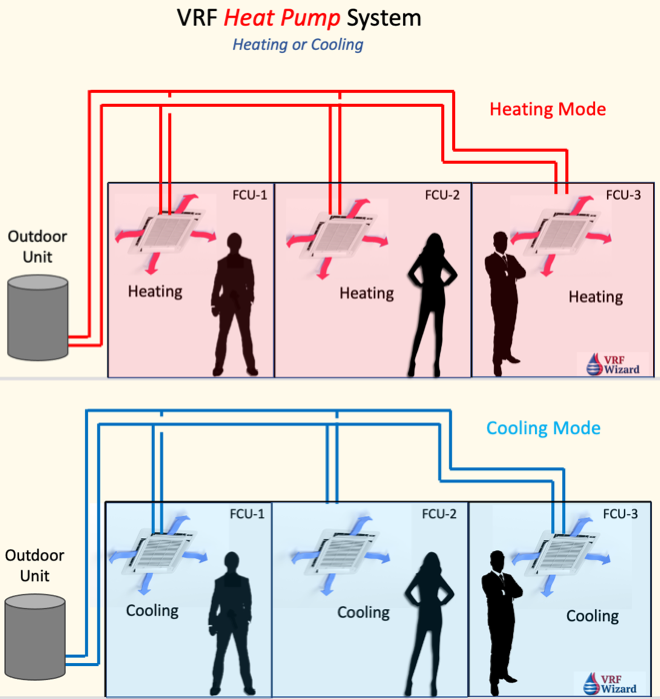

The reason this is important is that when the sun is shining brightly on the south glass, those exterior spaces will require cooling, while the north exposure may require heating because its shaded and much cooler. These zones would require simultaneous heating and cooling or separate systems. The same can be said of mixing interior with exterior zones, the exterior zone is dependent on the varying outside weather conditions, while the interior is usually consistent in its load profile.
If the cooling and heating load profile is somewhat balanced than this could be a good candidate for a VRF Heat Recovery system. With a Heat Recovery system, you can move heat around from a zone that wants cooling to a zone that wants heating. This is an efficient use of energy, in lieu of rejecting the heat to the outdoors in a conventional DX unit and then using some other form of heating source to provide heat.
When using a heat pump or heat recovery system, the designer needs to ensure that the minimum amount of heat is available when the outdoor temperature drops below the VRF manufacturers catalogue value. The catalogue will indicate the capacity for heating at some stated outside air temperature. In colder climates the designer must ensure that the VRF unit will be capable of maintaining the desired heating. See the derated values in the VRF manufactures catalogue for lower outdoor temperatures. If heating demand is higher than some form of supplemental heating can be provided.
Branch Controllers (Box Selectors)
The terminology for what is considered the refrigerant traffic monitor varies with each VRF manufacture. This is the selector box (Branch Controller) required for a VRF Heat Recovery system that directs the flow of refrigerant based on whether the zone is calling for heating or cooling. When using a VRF heat recovery system which is more expensive than a VRF Heat Pump system you’ll have the added cost of providing electrical to these boxes. Some VRF manufactures also require a condensate drain piping off their branch controllers. (see image above)
Sizing the Zones (Indoor Units)
The predominate load profile of either the cooling or heating will dictate how the indoor unit is selected. In extreme cold climates the indoor unit maybe selected based on its heating capacity to ensure that the maximum amount of heating is available. If the designer were to choose the indoor unit based on the cooling load in a location with very cold winters, then the heating capacity may fall short of the space requirement for heating. So, its’ imperative to select the indoor unit based on the maximum of either the cooling or heating, whichever is greater.
Based on the style of indoor unit, that is, if its ducted or non-ducted, you may be able to combine multiple spaces of the same thermal profile and exposure. The owner or Architect may have requirements about aesthetics if you are thinking of using any of the wall or ceiling mounted fan coils that are visible to the occupants.
The outdoor unit will be selected based on the Block Load of the building. The block load is the maximum combined peak load of all the zones at a given time of day. The total Btu’s would total up to an outdoor unit that is smaller than the total peak load of all the indoor units.
Occupancy Schedule
Depending on the type of facility there can be a wide variable in the time spaces are used. For instance, a school mostly has the same hours of operation for each classroom, while high occupancy areas such as assembly halls, conference rooms and meeting rooms can vary widely on time of use. You wouldn’t put these varying use schedules on the same zone. Rooms with large latent loads (moisture) caused by occupants or equipment will need to be closely looked at to ensure the latent load can be handled by the system. Remember that most VRF systems have high sensible heat ratios (SHR), which means they don’t deal efficiently with too much latent load.
VRF System Cost
As mentioned previously the VRF Heat Recovery system is going to cost more when compared to a VRF Heat Pump or Conventional DX unit. These additional cost we’ll have to be compared against any energy savings or system benefits. There are some cases where the added cost makes sense and for which a thorough analysis of the space requirements is required. If you are an HVAC contractor or Engineer that tracks the cost of VRF Systems, then see our VRF System Cost Spreadsheet for keeping track of these type of projects.
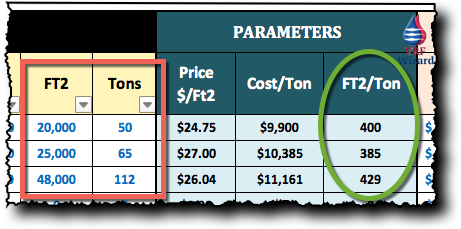

Space Requirements
VRF systems or split systems in general are great for retrofit projects because they’re less invasive to the existing conditions. It’s easier to route small copper piping through an existing structure then to route air ducts of the same capacity.
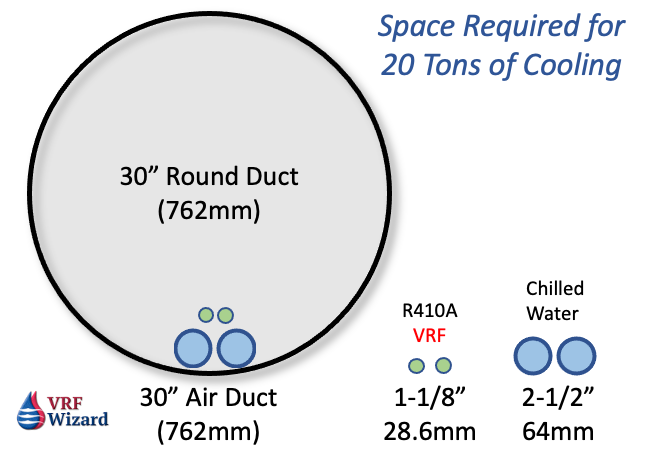

You’ll need space in the attic or ceiling for any selector boxes (branch controllers) when using a VRF Heat Recovery system.
All systems will need space on the ground or roof for the outdoor unit. Packaged DX units will take up the most space because all its components are in one box.
Electrical
A conventional rooftop DX unit is the simplest when considering electrical connections as there is only one point of connection. When using a VRF Heat Recovery system you’ll need at least three points of connection, the Outdoor Unit, Indoor Unit and Selector Box. With a VRF Heat Pump you’ll have two connections, the Outdoor Unit and Indoor Unit.
This doesn’t include small split systems where the outdoor unit comes with power wiring that feeds the Indoor unit, hence one connection.
- Packaged Unit – 1 Connection
- VRF Heat Pump – 2 Connections
- VRF Heat Recovery – 3 Connections
VRF Piping Limitations
Depending on the building configuration and where the outdoor units can be located, each VRF manufacture has limits to the distance piping can be between the outdoor units and the furthest indoor unit. This distance is calculated vertical as well as the overall distance between the outdoor and furthest indoor fan coil.
Of course even the standard DX split system has piping limitations that if exceeded degrades the tonnage.
Conventional DX System
If you choose not to use a VRF system, then you’ll need to consider other factors. Is there space on the roof for packaged DX equipment? Can the roof structure support the added weight, or will structural reinforcement be required? Is there space to run the ductwork from the packaged unit to the area it will serve?
A VRF system can carry more tonnage in a smaller space by using refrigerant piping to cool a space in lieu of ductwork from a packaged DX unit.
Remember also that you can use a mixture of VRF and conventional packaged DX systems to meet any project requirements. It’s not all or the other, as often designs will use the different benefits each of these systems brings to a project.
Summary
Using a VRF system is a good choice for many reasons but deciding on whether to use a straight VRF Heat Pump versus a VRF Heat Recovery system requires some additional analysis. If the decision is left up to you, then here are some questions you should ask yourself when considering whether to use a VRF system and which type to use.


- Can the zones be separated into similar exposure or heat gain profiles?
- Do the zones need simultaneous heating and cooling capabilities?
- Is cost a major consideration?
- How will you get code required ventilation to the space, and does it need to be preconditioned?
- Is there space for ducted fan coils and Selector Boxes (Branch Controllers) in the attic or ceiling space?
- What type of space is there for outdoor units?
- What is the occupancy schedule for the various spaces?
- Do the spaces meet the requirements for ASHRAE 15? (See our article on ASHRAE 15 & xxx)
- Will you need refrigerant monitoring?






